Uncategorized
The first Passover haggadah in Ukrainian marks a community’s break with Russia
(JTA) — For Michal Stamova, the challenge of translating Passover’s core text into Ukrainian started with the title.
The haggadah — the book containing the Passover story — starts with an “h” sound in both Hebrew, its original language, and English. In Russian, the primary language of organized Jewish life in Ukraine until recently, there is no such sound, so the book has long been known there as an “agada.”
Ukrainian does have an “h” sound. But the character representing that sound conveys a different sound in Russian: a “G.” So for many Ukrainian Jews, the cover of Stamova’s translation will read as “Gagada.”
The journey of that single sound reflects the complexity of the task Stamova took on to aid Ukrainian Jews celebrating Passover a year into their country’s war with Russia. A musicologist from western Ukraine who fled to Israel shortly after Russia’s invasion, Stamova was recruited to create a Ukrainian-language haggadah, a powerful sign of the community’s rupture with its Russophone past.
Stamova knew she wanted to base her translation not off the preexisting Russian translation, but from the original Hebrew and Aramaic. That proved challenging because much of the text of the haggadah is lifted from other sources in Jewish canon, but Jewish translations of those texts to Ukrainian are only underway now for the first time.
“At first, it was very difficult to start, because we don’t have the sources in Ukrainian,” Stamova said. “We don’t have Torah in Ukrainian. We don’t have Tanakh in Ukrainian. It was very difficult to know what words to find.”
Stamova’s text, titled “For Our Freedom,” was released online earlier this month in advance of the Passover holiday that starts April 5. It is one of a growing number of efforts to translate Jewish texts into Ukrainian. Translators affiliated with the Chabad-Lubavitch movement have produced a book of psalms and are working on a daily prayer book, with their sights set on a full translation of the Torah. An effort is also underway now to translate a chapter of a newer text associated with Yom Hashoah, the Jewish Holocaust memorial day, in advance of its commemoration this year on April 18.
The absence of those texts until now, despite Ukraine’s significant Jewish population, reflects the particular linguistic history of Ukrainian Jews. Under the Russian empire, Jews living in what is now Ukraine in the 19th century tended to adopt Russian rather than Ukrainian, usually in addition to Yiddish, because Ukrainian was perceived as the language of the peasantry and conferred few benefits. That tilt became more pronounced after World War II and the Holocaust, when Yiddish declined as a Jewish vernacular and Russian became the main language of the Soviet Union. The history helps explain why, even as the number of Ukrainians speaking Russian at home fell sharply over the last decade, Jews remained largely Russian-speaking. (Russian and Ukrainian are related linguistically, though their speakers cannot understand each other.)
A sample page of text from the haggadah. (Courtesy of Project Kesher)
Over the past 30 years, the vast majority of printed material used by Ukrainian Jewish communities, including haggadahs for Passover, were created in Russian by groups such as Chabad, which is the main Jewish presence in both countries. But after Russia’s invasion, those materials became a liability at a time when being perceived as having ties to the enemy could be dangerous.
Indeed, Russia’s invasion of Ukraine last year prompted many Russian-speaking Ukrainians to switch languages as a marker of national solidarity — and sparked a push to translate Ukraine’s Jewish life into the Ukrainian language.
“Ukrainian Jews always spoke Russian. That really was the norm. With the advent of the escalation of the war, that has shifted, and Ukrainian Jews who are in the country are shifting as fast as they can over to Ukrainian,” said Karyn Gershon, the executive director of Project Kesher, the global Jewish feminist nonprofit that commissioned the new haggadah.
Gershon said the haggadah offers an opportunity to elevate a Ukrainian Jewish identity in other ways, such as by including tidbits about famous Jewish writers from the area that comprises modern Ukraine who in the past might have been characterized only as “Russian.”
“In most of the Jewish world, the things that make a haggadah unique are the special readings,” Gershon said. The new Ukrainian haggadah includes alongside the traditional text, she said, “prayers for the defenders of Ukraine, prayers for peace in Ukraine, but also [passages] reclaiming writers who were always categorized as Russian, but because they came from places like Kyiv, Odessa and Berdichev, are more accurately Ukrainian.”
For example, the haggadah includes passages from the 1925 book “Passover Nights,” by Hava Shapiro, a Kyiv-born Jew and journalist who authored one of the first Hebrew-language diaries known to have been written by a woman.
The additions offer an element of pride for some of the Ukrainian Jews who plan to use the new haggadah.
“It is bringing you to the roots of those Jews who were living here before the Holocaust,” said Lena Pysina, who lives in Cherkasy, southeast of Kyiv. “It’s about rebuilding the Jewish communities in Ukraine as ‘Ukrainian Jews.’”
Pysina said the switch to Ukrainian and the embrace of Ukrainian Jewish history in some ways echoed the themes of the Passover story, which describes the Israelites fleeing slavery in Egypt.
“It’s like an exodus for us. It is not comfortable, because we get used to what we get used to. But we have to be proactive, we have to find our identity,” she said. “It took us 70 years of Soviet times to … celebrate the Jewish holidays and Jewish traditions. And it took us 30 years to understand that we have to build Ukrainian Jewish communities, too.”
Those communities are very much in flux a year into the war, with millions of Ukrainians internally displaced or having relocated overseas. Stamova undertook the haggadah project from Israel, where she is one of an estimated 15,000 Ukrainians who arrived since February 2022.
Stamova grew up in western Ukraine, where the use of the Ukrainian language is more common than in the east. Like most other Ukrainian Jews, she still grew up speaking Russian at home, but her school, university and most of her life outside the home was conducted in Ukrainian. That made her a natural fit for the translation project, along with her background in Jewish liturgy, which she had studied at a Conservative yeshiva in Jerusalem.
Over the past 30 years, the vast majority of printed material used by Ukrainian Jewish communities, including haggadahs for Passover, were created in Russian. (Courtesy of Project Kesher)
The challenges went beyond phonetics. One frequent question was whether to use Russianisms that are widely known in Ukrainian and would be more easily understandable to a Jewish audience, or to use uniquely Ukrainian words.
The most difficult section of the text, she said, was Hallel, the penultimate step of the Passover seder. Hallel is a lengthy song of divine praise heavy with poetry and allegorical language — making for challenging translation work in any language.
Stamova said she sought to stick to the traditional understanding of the text while also making some adjustments for the contemporary seder attendee. For example, the section of the haggadah about the “four sons” with varying relationships to Judaism is rendered gender-neutral and changed to the “four children” in Stamova’s translation — an adjustment that has been made in other languages, too.
Most of all, Stamova said, she hopes the haggadah offers some solace to Ukrainian Jews whose entire lives have been turned upside down.
“The Jewish tradition of Pesach is that we every year have to remember that we escaped from Egypt, from slavery. It’s very therapeutic,” Stamova said, using the Hebrew word for Passover. “How is it like therapy? Yes, we every year remember this difficult story, but then we have a plan for the future, we say next year in Jerusalem. So we have to have a plan. We have to see the future.”
—
The post The first Passover haggadah in Ukrainian marks a community’s break with Russia appeared first on Jewish Telegraphic Agency.
Uncategorized
How the Global Religious Landscape Changed from 2010 to 2020

Muslims grew fastest; Christians lagged behind global population increase
• Christians are the world’s largest religious group, at 28.8% of the global population. They are a majority everywhere except the Asia-Pacific and Middle East-North Africa regions. Sub-Saharan Africa has surpassed Europe in having the largest number of Christians. But Christians are shrinking as a share of the global population, as millions of Christians “switch” out of religion to become religiously unaffiliated.
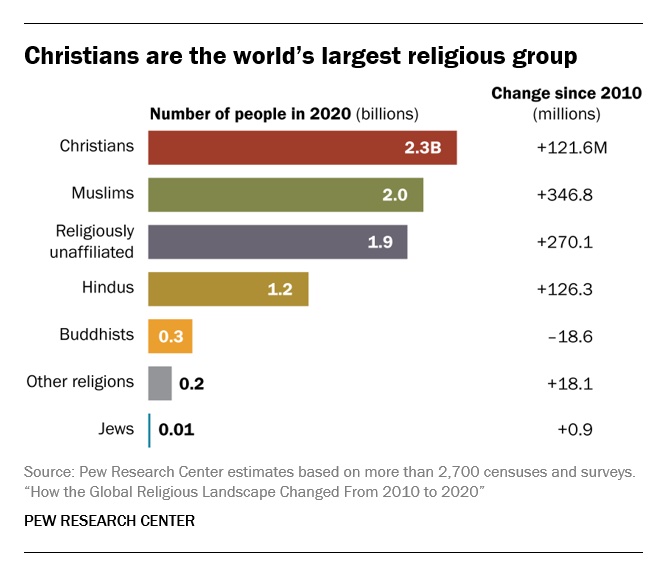
• Muslims are the world’s second-largest religious group (25.6% of the world’s population) and the fastest-growing major religion, largely due to Muslims’ relatively young age structure and high fertility rate. They make up the vast majority of the population in the Middle East-North Africa region. In all other regions, Muslims are a religious minority, including in the Asia-Pacific region (which is home to the greatest number of Muslims).
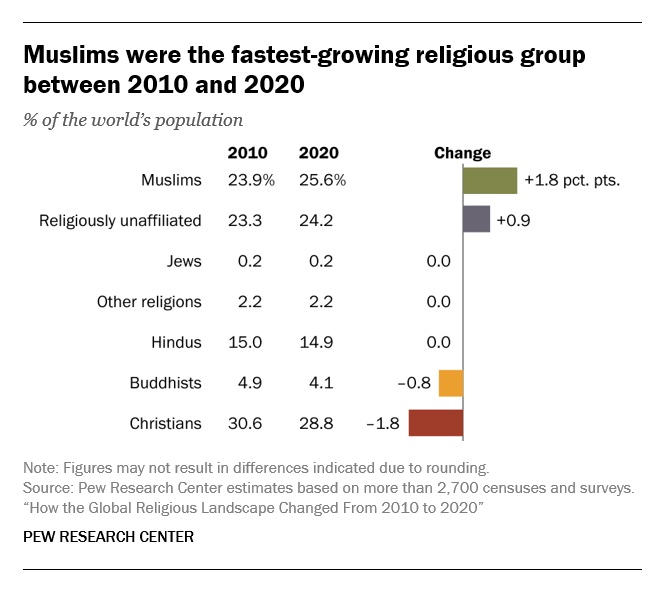
• The religiously unaffiliated population is the world’s third-largest religious category (24.2% of the global population), after Christians and Muslims. Between 2010 and 2020, religiously unaffiliated people grew more than any group except Muslims, despite their demographic disadvantages of an older age structure and relatively low fertility. The unaffiliated made up a majority of the population in 10 countries and territories in 2020, up from seven a decade earlier.
• Hindus are the fourth-largest religious category (14.9% of the world’s population), after Christians, Muslims and religiously unaffiliated people. Most (99%) live in the Asia-Pacific region; 95% of all Hindus live in India alone. Between 2010 and 2020, Hindus remained a stable share of the world’s population because their fertility resembles the global average, and surveys indicate that switching out of or into Hinduism is rare.
• Buddhists (4.1% of the world’s population) are the only group in this report whose number declined worldwide between 2010 and 2020. This was due both to religious disaffiliation among Buddhists in East Asia and to a relatively low birth rate among Buddhists, who tend to live in countries with older populations. Most of the world’s Buddhists (98%) reside in the Asia-Pacific region, the birthplace of Buddhism.
• Jews, the smallest religious group analyzed separately in this report (0.2% of the world’s population), lagged behind global population growth between 2010 and 2020 – despite having fertility rates on par with the global average – due to their older age structure. Most Jews live either in North America (primarily in the United States) or in the Middle East-North Africa region (almost exclusively in Israel).
These are among the key findings of a Pew Research Center analysis of more than 2,700 censuses and surveys, including census data releases that were delayed due to the coronavirus pandemic. This report is part of the Pew-Templeton Global Religious Futures project, which analyzes global religious change and its impact on societies around the world. Funding for the Global Religious Futures project comes from The Pew Charitable Trusts and the John Templeton Foundation.
Uncategorized
Antisemitism in some unlikely places in America

By HENRY SREBRNIK Antisemitism flourishes in a place where few might expect to confront it – medical schools and among doctors. It affects Jews, I think, more emotionally than Judeophobia in other fields.
Medicine has long been a Jewish profession with a history going back centuries. We all know the jokes about “my son – now also my daughter – the doctor.” Physicians take the Hippocratic Oath to heal the sick, regardless of their ethnicity or religion. When we are ill doctors often become the people who save us from debilitating illness and even death. So this is all the more shocking.
Yes, in earlier periods there were medical schools with quotas and hospitals who refused or limited the number of Jews they allowed to be affiliated with them. It’s why we built Jewish hospitals and practices. And of course, we all shudder at the history of Nazi doctors and euthanasia in Germany and in the concentration camps of Europe. But all this – so we thought – was a thing of a dark past. Yet now it has made a comeback, along with many other horrors we assume might never reappear.
Since the Hamas attack on Israel on October 7, 2023, there has been a resurgence of antisemitism, also noticeable in the world of healthcare. This is not just a Canadian issue. Two articles on the Jewish website Tablet, published Nov. 21, 2023, and May 18, 2025, spoke to this problem in American medicine as well, referencing a study by Ian Kingsbury and Jay P. Greene of Do No Harm, a health care advocacy group, based on data amassed by the organization Stop Antisemitism. They identified a wave of open Jew-hatred by medical professionals, medical schools, and professional associations, often driven by foreign-trained doctors importing the Jew-hatred of their native countries, suggesting “that a field entrusted with healing is becoming a licensed purveyor of hatred.”
Activists from Doctors Against Genocide, American Palestinian Women’s Association, and CODEPINK held a demonstration calling for an immediate cease-fire in Gaza at the Hart Senate Office Building in Washington, D.C., Nov. 16, 2023, almost as soon as the war began. A doctor in Tampa took to social media to post a Palestinian flag with the caption “about time!!!” The medical director of a cancer centre in Dearborn, Michigan, posted on social media: “What a beautiful morning. What a beautiful day.” Even in New York, a physician commented on Instagram that “Zionist settlers” got “a taste of their own medicine.” A Boston-based dentist was filmed ripping down posters of Israeli victims and a professor at the University of Pennsylvania Perelman School of Medicine did the same. Almost three-quarters of American medical associations felt the need to speak out on the war in Ukraine but almost three-quarters had nothing to say about the war in Israel.
Antisemitism in academic medical centres is fostering noxious environments which deprive Jewish healthcare professionals of their civil right to work in spaces free from discrimination and hate, according to a study by the Data & Analytics Department of StandWithUs, an international, non-partisan education organization that supports Israel and fights antisemitism.
“Academia today is increasingly cultivating an environment which is hostile to Jews, as well as members of other religious and ethnic groups,” StandWithUs director of data and analytics, and study co-author, Alexandra Fishman, said on May 5 in a press release. “Academic institutions should be upholding the integrity of scholarship, prioritizing civil discourse, rather than allowing bias or personal agendas to guide academic culture.”
The study, “Antisemitism in American Healthcare: The Role of Workplace Environment,” included survey data showing that 62.8 per cent of Jewish healthcare professionals employed by campus-based medical centres reported experiencing antisemitism, a far higher rate than those working in private practice and community hospitals. Fueling the rise in hate, it added, were repeated failures of DEI (diversity, equity, and inclusion) initiatives to educate workers about antisemitism, increasing, the report said, the likelihood of antisemitic activity.
“When administrators and colleagues understand what antisemitism looks like, it clearly correlates with less antisemitism in the workplace,” co-author and Yeshiva University professor Dr. Charles Auerbach reported. “Recognition is a powerful tool — institutions that foster awareness create safer, more inclusive environments for everyone.”
Last December, the Data & Analytics Department also published a study which found that nearly 40 per cent of Jewish American health-care professionals have encountered antisemitism in the workplace, either as witnesses or victims. The study included a survey of 645 Jewish health workers, a substantial number of whom said they were subject to “social and professional isolation.” The problem left more than one quarter of the survey cohort, 26.4 per cent, “feeling unsafe or threatened.”
The official journal of the Alliance for Academic Internal Medicine concurs. According to “The Moral Imperative of Countering Antisemitism in US Medicine – A Way Forward,” by Hedy S. Wald and Steven Roth, published in the October 2024 issue of the American Journal of Medicine, increased antisemitism in the United States has created a hostile learning and practice environment in medical settings. This includes instances of antisemitic behaviour and the use of antisemitic symbols at medical school commencements.
Examples of its impact upon medicine include medical students’ social media postings claiming that Jews wield disproportionate power, antisemitic slogans at the University of California, Los Angeles (UCLA) David Geffen School of Medicine, antisemitic graffiti at the University of California, San Francisco (UCSF) Cancer Centre, Jewish medical students’ exposure to demonization of Israel diatribes and rationalizing terrorism; and faculty, including a professor of medicine at UCSF, posting antisemitic tropes and derogatory comments about Jewish health care professionals. Jewish medical students’ fears of retribution, should they speak out, have been reported. “Our recent unpublished survey of Jewish physicians and trainees demonstrated a twofold increase from 40% to 88% for those who experienced antisemitism prior to vs after October 7,” they stated.
In some schools, Jewish faculty are speaking out. In February, the Jewish Faculty Resilience Group at UCLA accused the institution in an open letter of “ignoring” antisemitism at the School of Medicine, charging that its indifference to the matter “continues to encourage more antisemitism.” It added that discrimination at the medical school has caused demonstrable harm to Jewish students and faculty. Student clubs, it said, are denied recognition for arbitrary reasons; Jewish faculty whose ethnic backgrounds were previously unknown are purged from the payrolls upon being identified as Jews; and anyone who refuses to participate in anti-Zionist events is “intimidated” and pressured.
Given these findings, many American physicians are worried not only as Jewish doctors and professionals, but for Jewish patients who are more than ever concerned with whom they’re meeting. Can we really conceive of a future where you’re not sure if “the doctor will hate you now?”
Henry Srebrnik is a professor of political science at the University of Prince Edward Island.
Uncategorized
The 2025 Toronto Walk (and talk ) for Israel
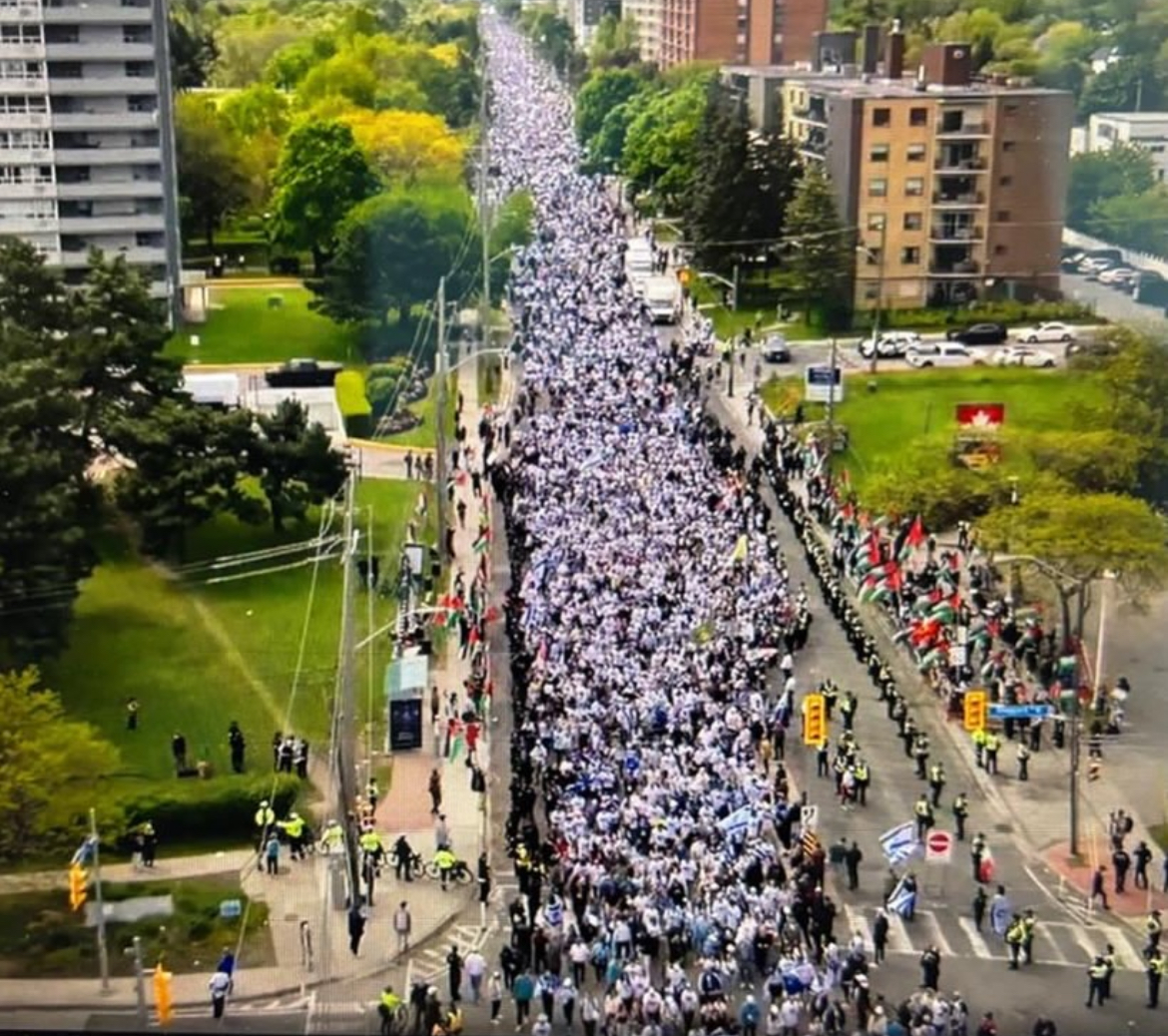
By GERRY POSNER There are walks and then there are walks. The Toronto UJA Walk for Israel on May 25, 2025 was one of a kind, at least as far as Canada and Jews are concerned. The number of people present was estimated to be 56,000 people or 112,000 total shoes. (How they get to that number is bewildering to me, since there is no one counting). This was 6,000 more than last year. Whether it is true or not, take it from me, it was packed. The synagogues in Canada should be so fortunate to get those numbers in total on High Holidays. The picture here gives you a sense of the size of the crowd.
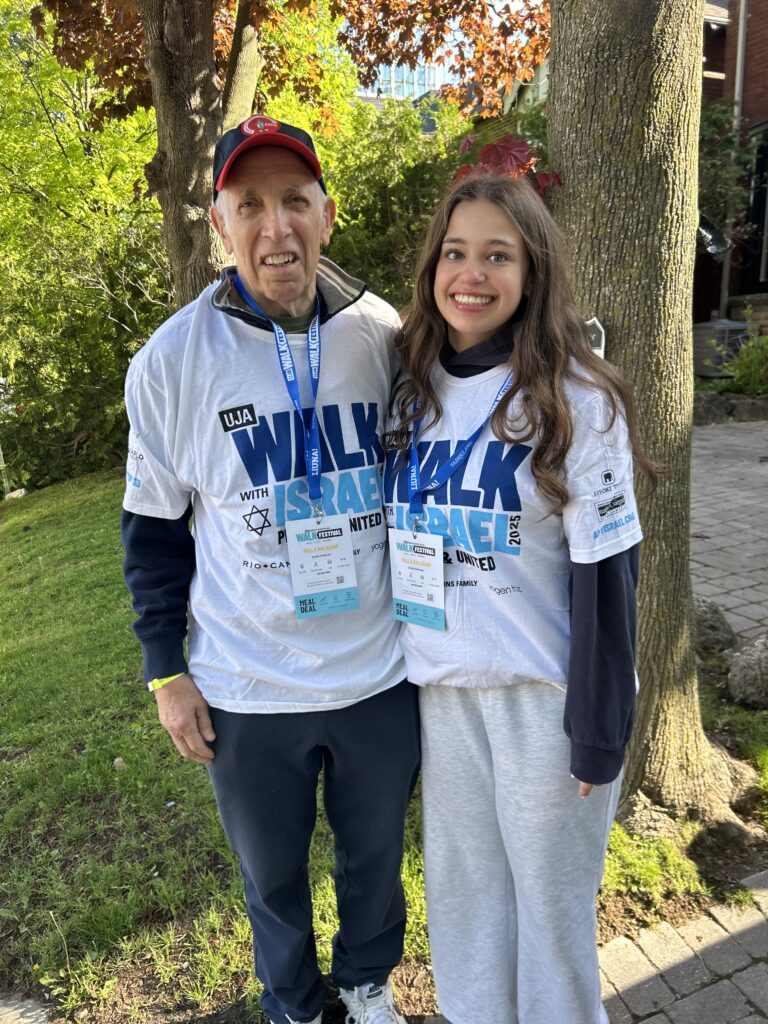
This was my first walk in Toronto for Israel and I was with my granddaughter, Samantha Pyzer (not to forget her two friends whom she managed to meet at the site, no small feat, even with iPhones as aids). The official proceedings began at 9:00 a.m. and the walk at 10:00 a.m. There was entertainment to begin with, also along the way, and at the finish as well. The finish line this year was the Prosserman Centre or the JCC as it often called. The walk itself was perhaps 4 kilometres – not very long, but the walking was slow, especially at the beginning. There were lots of strollers, even baby carriages, though I did not see any wheelchairs. All ages participated on this walk. I figured, based on what I could see on the faces of people all around me that, although I was not the oldest one on the walk, I bet I made the top 100 – more likely the top 20.
What was a highlight for me was the number of Winnipeggers I met, both past and present. Connecting with them seemed to be much like a fluke. No doubt, I missed la lot of them, but I saw, in no particular order (I could not recall the order if my life depended on it): Alta Sigesmund, (who was, a long time ago, my daughter Amira’s teacher), Marni Samphir, Karla Berbrayer and her husband Dr. Allan Kraut and family. Then, when Samantha and I made it to the end and sat down to eat, I struck up a conversation with a woman unknown to me and as we chatted, she confirmed her former Winnipeg status as a sister-in- law to David Devere, as in Betty Shwemer, the sister of Cecile Devere. I also chanced upon Terri Cherniack, only because I paused for a moment and she spotted me. As we closed in near the finish, I met ( hey were on their way back), Earl and Suzanne Golden and son Matthew, as well as Daniel Glazerman. That stop caused me to lose my granddaughter and her pals. Try finding them amid the noise and size of the crowd – but I pulled it off.
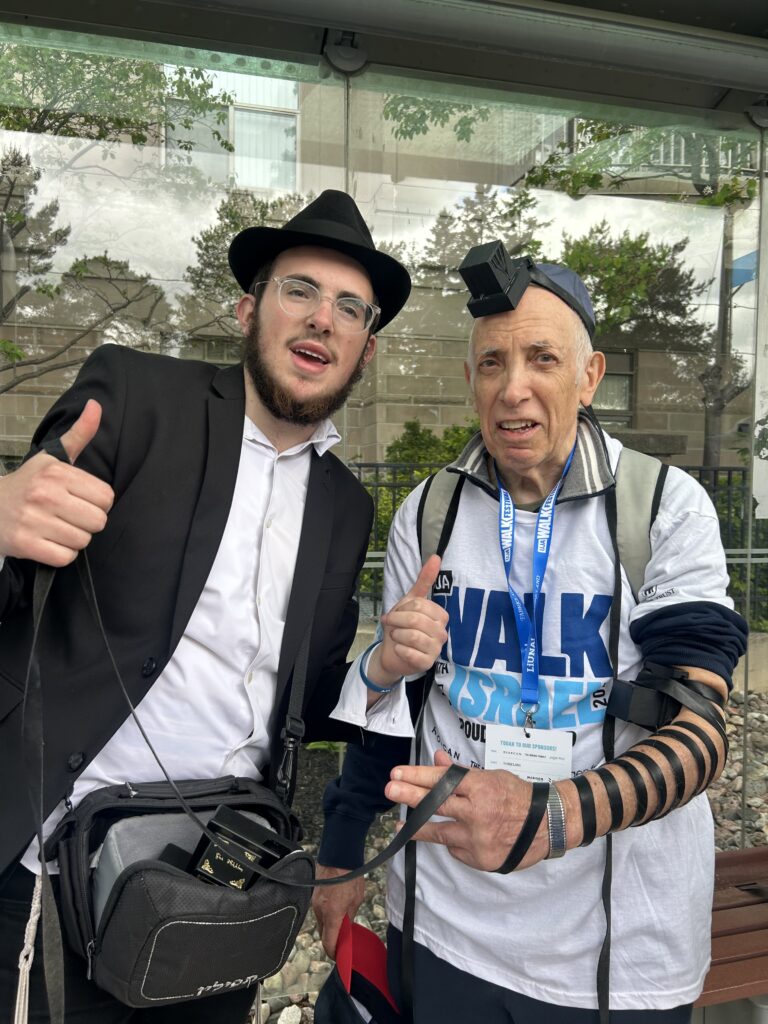
As I was in line to get food, I started chatting with a guy in the vicinity of my age. I dropped the Winnipeg link and the floodgates opened with “ Did I know Jack and Joanie Rusen?” So that was an interesting few minutes. And I was not too terribly surprised to come across some of my Pickleball family. All of these meetings, along with spotting some of my sister’s family and other cousins, were carried on with the sound of the shofar as we moved along the way. In short, this was a happening. Merchants selling a variety of products, many of them Israeli based, were in evidence and, of course, the day could not have ended without the laying of tefillin, aided by Chabad, who have perfected the procedure to take less than a minute. See the photo. Chabad had a willing audience.
Aside from the joy of sharing this experience with my granddaughter, the very presence of all these Jews gathered together for a common reason made this day very special to me. However, there was a downside to the day. The downside was that, as we began to walk back to our car there was no other way I could figure out how to return when the rains came and came. While we walked faster, we were impeded by pouring rain and puddles. But Samantha wanted to persevere, as did I. We made it, but were drenched. My runners are still drying out as I write this two days later.
What with being surrounded by 56,000 people, the noise, the slow walking, and the rain, I can still say the day was a real highlight for me – one of the better moments since our arrival in Toronto in 2012. As well as the photos we took along the way, I have the reminder of the day, courtesy of the UJA, as evidenced from the photo. It was not just the walk, but the talk that accompanied the walk that made it so worthwhile for me. I would do it again, minus the rain.
